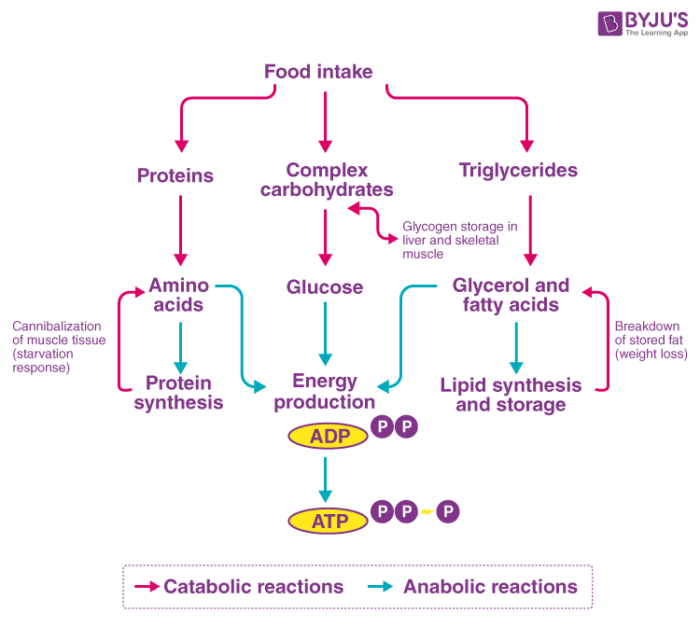A Feature of Catabolic Reactions Is That They
Option C is the correct answer. They often produce NADH or FADH2 C.

Solved 21 All Of The Following Are Characteristics Of Chegg Com
The sum total of both types of reactions is the cells metabolism.

. C involve release of energy. The anabolic hormones are responsible for growth and tissue repair. C involve release of energy.
A feature of catabolic reactions is that they a. They are divergent processes in which a few precursors form a wide variety of. Catabolism is the set of biochemical reactions that break down complex molecules into simpler ones.
Catabolic reactions are the breakdown of organic molecules for energy. A occur only in mitochondria. Such chemical reactions in which complex molecules are broken down to simpler components are classified as catabolic reactions.
Critical Enzyme Reactions In Aromatic Catabolism For Microbial Lignin Conversion Nature Catalysis. A feature of catabolic reactions is that they involve release of energy. You could also think of CATS that tear apart your furniture.
D involve consumption of energy. Taken as a group of reactions within a cell or even an organism they can be referred to as the cells or organisms anabolism or catabolism. Involve the release of energy b.
To remember what catabolic means think a CATastrophe where things are falling apart and breaking apart. Catabolism is the part of the metabolic process that breaks down large complicated molecules into smaller ones in order to produce energy. Glycolysis is an example of a catabolic.
Catabolic reactions break down molecules and release energy by braking down complex molecules to simpler compounds. Marked by or promoting metabolic activity concerned with the breakdown of complex molecules such as proteins or lipids and the release of energy within the organism. The reaction rates of these reactions the so called fluxes are summarized in the n 1 flux vector v molgDWh.
Catabolic reactions also called catabolism break down larger more complex molecules into smaller molecules and release energy in the process. The smaller end products of a catabolic reaction may be released as waste or they may be fed into other reactions. The Catabolism process is the action of the set of metabolic pathways that breaks down molecules into smaller units that are either oxidized to release energy or used in other anabolic reactions.
Released by the adrenal gland in response to stress. In catabolic reactions energy are release into the surrounding and the energy of the product formed is less than that of the reactants that is there is. A feature of catabolic reactions is that they involve release of energy.
When people want to lose weight they are taking advantage of catabolic reactions. AIEEE Bank Exams. They serve to generate energy.
Catabolism is exergonic meaning it releases heat and works via hydrolysis and oxidation. Catabolic processes are thermodynamically favorable and spontaneous so cells use them to generate energy or to fuel anabolism. Overview Of Metabolic Reactions Anatomy And Physiology Ii.
Occur only during loss of body weight. The energy that is released by catabolic reactions can be captured and used in. All reactions are classified as reversible or.
Occur only in the mitochondria c. Which of the following describes catabolic reactions. Other energy-storing molecules such as fats are also broken down through similar catabolic reactions to.
Involve consumption of energy d. A feature of catabolic reactions is that they involve release of energy. A very good example is Glycolysis which involves the break down of Glucose while using O_2 into CO_2 and energy.
Doccur only during loss of body weight. Catabolic reactions or catabolism is a type of reaction that occurs in living organisms or living cellsIt results in the breakage of large or medium molecules into smaller molecules. Hormones that stimulate catabolic reactions are also known as catabolic hormones.
Relating to characterized by or stimulating catabolism If the anabolic and catabolic processes are in balance tissue remains intact and good health is sustained. Cortisol - Stimulates gluconeogenesis. Cinvolve consumption of energy.
B-They are endergonic reactions that break down large macromolecules into their. Of course when people talk about losing weight they are generally wanting to lose fat. Occur only in mitochondria.
Which one of the following statements is NOT characteristic of catabolic reactions. B occur only during loss of body weight. They often involve hydrolysis of macromolecules.
There are many different kinds and examples of. Molecular energy stored in the bonds of complex molecules is released in catabolic pathways and harvested in such a way that it can be used to produce ATP. A feature of catabolic reactions is that they Ainvolve release of energy.
Involve consumption of energy. Bacterial Cellular Metabolic Systems 2013. Catabolism Definition Metabolism Stages With Videos Examples.
A feature of catabolic reactions is that they. The break down of glycogen is glucose and is a catabolic reaction. A Feature of Catabolic Reactions Is That They.
Breaking down sugars for energy fat for energy and so forth are all catabolic. A-They are exergonic reactions that build large macromolecules from smaller building blocks. Boccur only in mitochondria.
Growth of the cell is represented as a pseudo-reaction to biomass which is defined as an extracellular compound yielding m ext 1 extracellular metabolites in total. By Ra_Alivia968 11 Apr 2022 Post a Comment. Catabolism is defined as all chemical or enzymatic reactions involved in the breakdown of organic or inorganic materials such as proteins sugars fatty acids etc.

Overview Of Metabolic Reactions Anatomy And Physiology Ii

Overview Of Metabolic Reactions Anatomy And Physiology Ii

Catabolism Definition Metabolism Stages With Videos Examples
Comments
Post a Comment